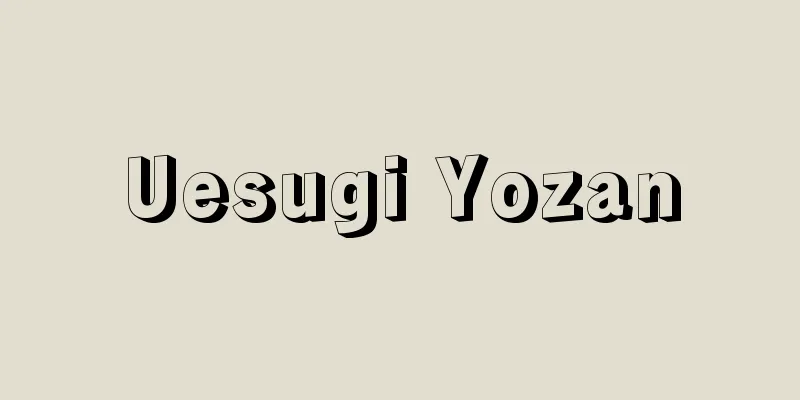Shinbutsu Shugo - syncretism of Shinto and Buddhism

|
The fusion and harmony of Shinto and Buddhist beliefs. Shugo is essentially the combination or compromise of different doctrines and teachings, and the Honji Suijaku theory is an example of this. Therefore, in the strict sense, Shinbutsu Shugo in Japan existed from the early 10th century until 1868 (Meiji 1), and before that it should simply be called Shinbutsu Chowa. After Buddhism was introduced to Japan, Prince Shotoku's active promotion of Buddhism and the assimilation of Buddhism itself influenced the practice of chanting and copying sutras in front of shrines from around the Hakuho period, and since the Tenpyo period, Japanese gods have been converted to Buddhism and have been believed to wish to practice good deeds, so shrine temples were built next to shrines as a place for this purpose, which can be said to be a harmony between Shinto and Buddhism. Regarding the time of the establishment of Shinto-Buddhist syncretism and the Honji Suijaku theory, "Seppo Meigen Ronsho" states that it was Prince Shotoku, "Genko Shakusho" states that it was Gyoki, and "Todaiji Yoroku" and "Todaiji Engi" state that it was Kukai or Saicho, but all of these claims should be denied. There is no evidence that such ideas and beliefs already existed at that time. The Honji Suijaku theory states that the absolute Buddha in India, that is, the original being, became a god in Japan and left his mark in order to benefit humans and save all living beings. The theory states that all Japanese gods and deities originated as Buddhas, and that Buddhas and gods are all originally one. In China, the syncretism of this ancient belief with Buddhism is said to have existed since the Six Dynasties, before the Sui and Tang dynasties, but it was not until the 10th century that the fundamental view of gods and Buddhas and the theory of honji suijaku arose in Japan. The word "suijaku" appears in the Sandai Jitsuroku, but in a different sense from the one mentioned here. The first time the word was actually used as the honji suijaku theory was in a document held by Iwashimizu Hachimangu Shrine, in a Dazaifu letter dated October 4, 937. In other words, it is written that "gongen bodhisattva suijaku" was used in relation to the deities enshrined at Hakozaki Shrine and Usa Shrine. From this point on, it is believed that the full-scale idea of Shinbutsu syncretism was born around that time. It is not known exactly who or when it was first put forward, but it is certain that it was put forward by Buddhists, judging from the religious organization and doctrine. Also, at that time it was still vague, and it seems that the stage of identifying which gods were the suijaku of which Buddhas came a little later. Prior to that, in the Engishiki Shinmeicho (Book of Divine Names) Hitachi Province (Ibaraki Prefecture), there are four shrines with the name Bodhisattva, such as Oarai Isosaki Yakushi Bodhisattva Shrine, Sakatsura Isosaki Yakushi Bodhisattva Shrine, Hachiman Daibosatsu Hakozaki Shrine in Chikuzen Province (Fukuoka Prefecture), and Hachiman Daibosatsu Usa Shrine in Buzen Province (Oita Prefecture). There is some doubt as to whether this Bodhisattva was used in the way that it is recited in Buddhism, but such names are sometimes given to gods and used as shrine names, and it is believed that this is how the Honji Suijaku theory gradually emerged. Around the time of the Kanko era (1004-1012), names such as Kumano Gongen and Atsuta Gongen began to appear, and the original form of each deity became generally clear, as noted in the Choshu-ki (Choshuuki) entry for 1134, which states that the original form of Ketsumiko of Kumano Hongu is Amida Buddha, the original form of Musubinomiya (Musubi no Kami) is Senju Kannon, and the original form of Hayatama Myojin is Yakushi Nyorai. From then on, syncretic Shinto-Buddhist beliefs and ideas were widespread among the people until 1868, when the Meiji Restoration government, based on the fundamental principle of the Restoration of Shintoism, issued the Shinbutsu Bunri Rei (Shinbutsu Bunri Rei) order, which separated Shinto and Buddhism. [Junichi Kamata] [Reference items] | | |A map of the temple grounds. Climbing the cliff path leads to the Niomon Gate, and climbing further leads to the Romon Gate. The large building to the left of the Romon Gate is the shrine temple, which was established as a result of the syncretism of Shinto and Buddhism. The gabled roof building built on the cliff is the worship hall, and opposite it are the shrine buildings on podiums. Part of "Ippen Shonin Eden" (copy held by the National Diet Library ) Kumano Nachi Taisha Shrine as seen in the "Eden of Ippen Shonin" Source: Shogakukan Encyclopedia Nipponica About Encyclopedia Nipponica Information | Legend |
|
神道(しんとう)信仰と仏教信仰とを融合調和すること。習合とは、本来相異なる教義・教理を結合また折衷することであり、本地垂迹(ほんじすいじゃく)説がそれにあたる。よって、厳密な意味での日本における神仏習合は、10世紀初期よりのち1868年(明治1)までに存したものであり、それ以前は単に神仏調和とでもいうべきであろう。 日本への仏教伝来以降、聖徳太子の積極的な仏教奨励策、また仏教そのものの同化性のあったことも影響して、白鳳(はくほう)時代ころより神前で読経(どきょう)・写経などが行われ、天平(てんぴょう)時代より日本の神は仏道に帰依(きえ)し、福業を修行しようと欲しているものとみて、そのための場として、神社に付属して神宮寺を建立したことなどは、神仏調和というべきことである。神仏習合、本地垂迹説の成立時期について、『説法明眼論抄』には聖徳太子によってと記し、『元亨釈書(げんこうしゃくしょ)』では行基(ぎょうき)よりと説き、『東大寺要録』『東大寺縁起』などでは空海(くうかい)また最澄(さいちょう)らよりと説くが、いずれも否定されるべきものである。その当時にすでにそのような思想、信仰が存したとのような証拠はない。 その本地垂迹説とは、本地すなわちインドにおける絶対的な仏陀(ぶっだ)が、人間を利益(りやく)し、衆生(しゅじょう)を済度(さいど)せんがために、日本では神となって迹(あと)を垂れるという説で、日本の神祇(じんぎ)は、もとを尋ねるとみな仏であり、仏も神もみな、もとは一つであるとの説であり、中国ではその古代信仰と仏教との習合は、隋唐(ずいとう)以前六朝(りくちょう)時代よりあったとされるが、日本でその基礎となるような神観、仏観が生じ、本地垂迹説が生じたのは、10世紀に入ってからのことである。『三代実録』のなかに「垂迹」の語はみられるが、ここでいう意味とは別の意であり、本地垂迹説としての実質的なその語の初見は、石清水八幡宮(いわしみずはちまんぐう)所蔵文書中の承平(じょうへい)7年(937)10月4日付けの大宰府牒(だざいふのちょう)のなかでである。すなわち、そこで筥崎(はこざき)宮・宇佐(うさ)宮の祭神に関連して「権現菩薩(ごんげんぼさつ)垂迹」と記されているのがそれである。これよりして、およそそのころ本格的な神仏習合思想が生じたものとみられる。それがだれによって、いつ唱えられたか正確にはわからないが、その教団、教義より推して、仏教者側から唱えられたことは確かであろう。また、その当時においてそれはなお漠然としたものであり、どの神がどの仏の垂迹とのような段階はもう少し後のものとみられる。 それより前、『延喜式(えんぎしき)』神名帳常陸(ひたち)国(茨城県)のなかに、大洗磯前(おおあらいいそさき)薬師菩薩神社、酒列(さかつら)磯前薬師菩薩神社、筑前(ちくぜん)国(福岡県)に八幡大菩薩筥崎宮、豊前(ぶぜん)国(大分県)に八幡大菩薩宇佐宮とのように菩薩号の4社がみられる。この菩薩が仏教で唱える意味どおりに使用されたのかどうかに疑問はあるが、このような名が神につけられ、神社名とされることがあり、このようなことからしだいに本地垂迹説が生じてきたものとみられる。寛弘(かんこう)(1004~1012)ころには熊野権現、熱田(あつた)権現などの名もみえるようになり、『長秋記(ちょうしゅうき)』長承(ちょうしょう)3年(1134)の条に、熊野本宮の家津王子(けつみこ)の本地は阿弥陀仏(あみだぶつ)、結宮(むすびのみや)(牟須美(むすびの)神)の本地は千手観音(せんじゅかんのん)、早玉(はやたま)明神の本地は薬師如来(にょらい)と記すように、一般にその本地がはっきりと示されるようになる。以降、1868年、王政復古の実現とともに、復古神道(ふっこしんとう)を基礎理念とした明治維新政府が発令したいわゆる神仏判然令(神仏分離令)によって神仏が分離されるまで、神仏習合した信仰や思想は、国民の間に広く浸透していたのである。 [鎌田純一] [参照項目] | | |境内の図。懸崖の道を登ると仁王門、さらに登ると楼門に達する。楼門左の大きな建物は、神仏習合により設けられた神宮寺。懸崖の上に建つ入母屋造の建物は礼殿、その向かいに基壇を設けた社殿が並ぶ。『一遍上人絵伝』(部分) 写国立国会図書館所蔵"> 『一遍上人絵伝』にみる熊野那智大社 出典 小学館 日本大百科全書(ニッポニカ)日本大百科全書(ニッポニカ)について 情報 | 凡例 |
>>: Mrs. Simpson - Simpson, Wallis Warfield (Duchess of Windsor)
Recommend
Cucumber Beetle - Cucumber Beetle
It is an insect belonging to the family Chrysomel...
Liquid Seal - Stationary Seal
A type of sealing device used in high-speed rotati...
Esaki - Esaki
This is the former area of the northeastern part...
Shaykh (English spelling)
In Arab and Islamic societies, the title of respec...
Zamość (English spelling)
A city in Lubelskie Voivodeship in eastern Poland....
Sŏng Sam‐mun (English spelling)
1418‐56 A Korean scholar and official of the Yi Dy...
preliminary examination
...Disclosure of the reasons for detention is a p...
Abor tribe - Aboruzoku
…A large mountain range that borders the Tibetan ...
Early Modern Society
The word "modern times" has different me...
Wang Xitian murder case
...This act was meant as a security law to replac...
Sea fan (Padina arborescens)
A brown algae of the Dictyogramma order and Dictyo...
Ara militaris (English spelling)
…Parakeet [Takashi Saito]. . . *Some of the termi...
News
In a narrow sense, it refers to periodical printe...
Galinsoga parviflora (English spelling) Galinsoga parviflora
…[Hiroji Koyama]. . … *Some of the terminology th...
Kumarajiva
A Buddhist monk who translated Buddhist scriptures...









